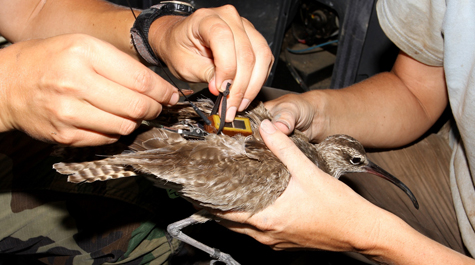Two tracked whimbrels survive storms—only to die of gunfire
Goshen and Machi, half of the quartet of whimbrels that survived encounters with Hurricane Irene, have been killed by hunters in the Caribbean island of Guadeloupe.
The shootings—though tragic—were perfectly legal, says Bryan Watts of the Center for Conservation Biology. Guadeloupe is an overseas department of France and shorebird hunting is legal and even traditional there.
“Machi and Goshen highlight a conflict that has been brewing for quite a while now,” Watts said. “The situation is that we have countries like the U.S. and Canada who are spending millions of dollars for the recovery of shorebird species, yet we have these holdouts in some places that continue to support legalized hunting.”
Whimbrels are long-legged, long-billed birds known for distance flying, migrating each year between arctic breeding grounds and wintering areas in the tropics. The Center for Conservation Biology is part of a group that have tracked whimbrel migrations by equipping some birds with solar-powered satellite transmitters.
Watts said satellite tracking indicated that the two birds were not flying together, but were killed on the morning of Sept. 12 after being diverted to Guadeloupe as they avoided different storm systems. Goshen flew through the east side of Hurricane Irene, landed on Montserrat, spent a week on Antigua and then flew to Guadeloupe. Machi flew through Tropical Storm Maria, landed on Montserrat and then flew directly to Guadeloupe.
Chinquapin, one of the whimbrels currently being tracked, made national news after he successfully flew through the teeth of the dangerous northeast quadrant of Hurricane Irene.
Machi was netted on Virginia’s Eastern Shore in August of 2009. During the two years, she had been tracked for over 27,000 miles back and forth between breeding grounds in the Hudson Bay Lowlands of Canada to wintering grounds near São Luís, Brazil. The bird was tracked on seven nonstop flights of more than 2,000 miles. During the spring of 2010, Machi flew more than 3,400 miles directly from Brazil to South Carolina.
Watts said that Machi was an experienced storm flier. “This bird has had a number of encounters with storms. She ran into a storm coming back from Brazil to the Atlantic coast in spring of 2010 and set down in some sugarcane fields in south Florida,” Watts said.
Whimbrels and other shorebirds are not usually considered game birds in North America, Watts said. He explained that sports shooting from blinds are a long tradition in many areas of the Caribbean. Such places are not signatories to bird-protection agreements such as the Migratory Bird Treaty Act of 1918.
“The legal hunting there is just a holdover from the past,” Watts said. “It’s something that needs to be addressed. What happened to Machi and Goshen highlights this ongoing political issue.”
He added that legal hunting on the island nation of Barbados alone is responsible for the death of around 30,000 shorebirds each year. The dead-bird count from Guadeloupe and all the other legal shorebird hunts throughout the Caribbean is unknown. Watts pointed out that Machi and Goshen were the first tracked whimbrels to set down on Guadeloupe. The fact that both were killed within hours of their arrival suggests that the hunting pressure on the island is enormous, he said.
“Machi and Goshen contributed a great deal to what we know about whimbrel migration along the western Atlantic,” Watts said. Whimbrel tracking has allowed scientists to understand the importance of comparatively small areas—including the Eastern Shore—to the continued well being of the species.
Satellite tracks of the migration routes of Machi and Goshen are available online.
The whimbrel tracking project is a collaborative effort among the Center for Conservation Biology, The Nature Conservancy, the U.S. Fish and Wildlife Service, Georgia Department of Natural Resources, the Virginia Coastal Zone Management Program and Manomet Center for Conservation Sciences.
The Center for Conservation Biology is a joint program of the College of William & Mary and Virginia Commonwealth University.
















